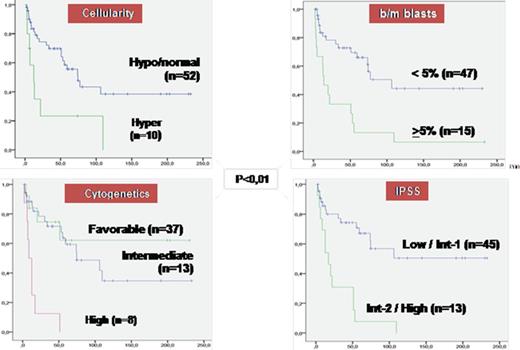Abstract
Introduction
The majority of clinical recommendations on MDS indicate the use of IST for low-risk hypoplastic MDS patients. ATG followed by cyclosporine A (CSA) is recommended for younger pts with normal karyotype or with +8, CSA - for older patients with autoimmune phenomenon or hypoplastic bone marrow. There are no reports on the use of CSA with splenectomy as a combined IST for MDS patients. Here we report the long term (20 years) results of the single center trial comprising 61 MDS pts treated with CSA as the first or the second line treatment + splenectomy.
Patients and methods. Since 1995 till June 2015, 61 patients were included in the combined IST protocol. There were 34 males, 27 females; median age constituted 39 years (16-74), refractory cytopenias with multileaneage dysplasia = 46, RAEB1/2 = 15; IPSS - low-risk= 4, intermediate 1 =40, intermediate-2 =9, high =4; no risk evaluation - 4 patients. All patients had trepanobiopsy evaluation, half of them - bilateral. It worth to note that bilateral trepanobiopsy permitted to redefine cellularity in 15% of patients. Pure hypoplastic forms of MDS were registered in 38 patients (63%), combination of hypoplasia with hyperplasia or normal cellularity - in 10 (16%), hyperplastic forms - in 13 (21%); non-clonal lymphoid nodules in b/m were detected in 29 pts (46%); fibrosis - in 7. Cytogenetics was done in 57 pts, 32 had normal karyotype; 5 had trisomy 8; 8 - high risk cytogenetics (-7/7q-, complex); 8 - different intermediate.
Cyclosporine A was applied at a dose 5 mg/kg per day, followed by reevaluation of response at 2-3 months. In case of response CSA was continued, if there was no response or it was inadequate - splenectomy was done followed again by CSA; if progression occurred - CSA was stopped. We consider splenectomy as a component of the programmed IST as it leads to removement of a big lymphoid organ. For younger patients ATG for 20 mg/kg for 5 days could become the 2nd or the 3rd line of treatment. For patients with sibling donors allogeneic HSCT was an option.
Analysis was carried out in June 2015. The patients were grouped for analysis according to cellularity (hypo vs hyper, in case of combination hypo with hyper/normal the case was considered as hypocellular), % of b/m blast cells (<> 5%), IPSS index (low/int-1 vs int-2/high), cytogenetics, the presence of lymphoid nodules.
Results. CSA was started as the 1st line treatment in 42 patients, as the second line (after ATG or splenectomy or ESA) - in 20. 5 patients were transplanted from sibling donors. 35 patients received CSA as monotherapy (16 of them had a progression or a transformation to AML). Totally splenectomy was performed in 20 patients, in 8 patients it was followed by additional immunosuppression with ATG (9 patients) or MMF (1 patient). Splenectomy was performed by laparoscopy, no deaths or sever complications were noted. Half of the splenectomized patients achieved sustained response after operation and continuation of CSA. On the whole 18 patients had progression to RAEB or transformation to AML (1 from low-risk group, 7 - int1, 6 - int2, 5 - from high risk). Complete remission was achieved in 15 patients (24%), with overall response rate of 56% (n=34) with a median duration of response - 21 months (1-230 mo).
The 20-years survival data revealed highly statistical difference between hypoplastic forms of MDS vs hyperplastic (38% vs 0%), bone marrow blast cells less vs more than 5% (43% vs 5%), IPSS categories low/int1 vs int2/high (50% vs 0%), cytogenetics favorable vs intermediate vs high (62% vs 35% vs 0%) (Pic.1). No differences were detected in patients with or without lymphoid nodules in b/m (38% vs 35%).
Conclusions
Our small but prolonged study has demonstrated a substantial long-term efficacy of the combined IST. CSA followed by splenectomy is a reasonable treatment approach in MDS patients with hypoplastic features in bone marrow, normal or intermediate karyotype, low blast cell count, low/int1 IPSS score.
Pic.1 Overall survival of MDS patients treated with combined IST depending on cellularity, blast cells count, cytogenetic features and IPSS score.
No relevant conflicts of interest to declare.
Author notes
Asterisk with author names denotes non-ASH members.


